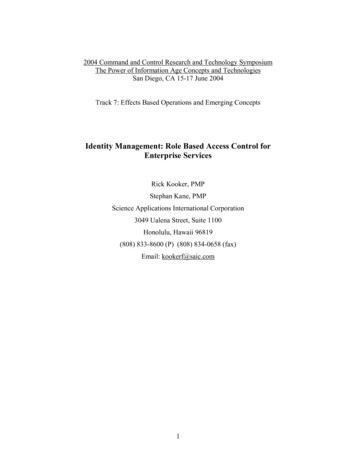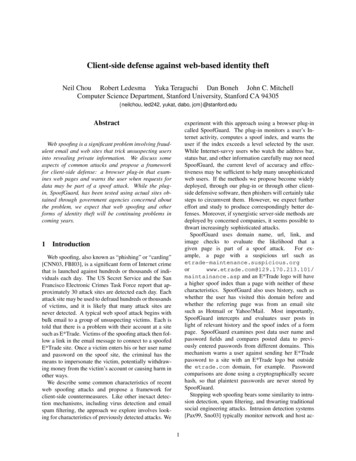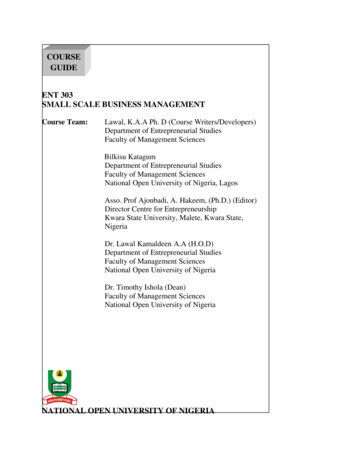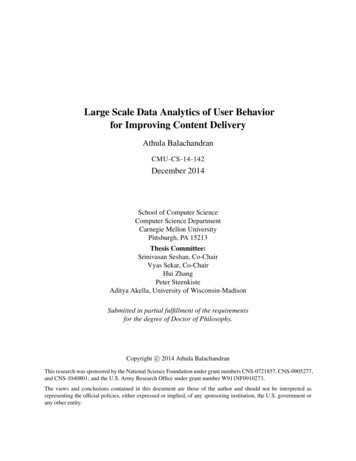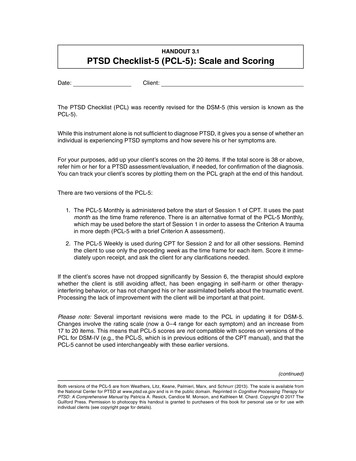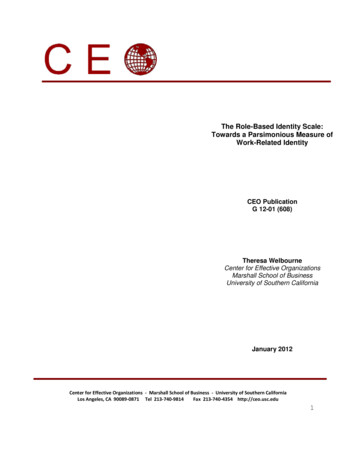
Transcription
The Role-Based Identity Scale:Towards a Parsimonious Measure ofWork-Related IdentityCEO PublicationG 12-01 (608)Theresa WelbourneCenter for Effective OrganizationsMarshall School of BusinessUniversity of Southern CaliforniaJanuary 2012Center for Effective Organizations - Marshall School of Business - University of Southern CaliforniaLos Angeles, CA 90089-0871 Tel 213-740-9814Fax 213-740-4354 http://ceo.usc.edu1
The Role-Based Identity Scale:Towards a Parsimonious Measure ofWork-Related IdentityTheresa M. WelbourneResearch ProfessorCenter for Effective OrganizationsUniversity of Southern CaliforniaMailing address:1705 Woodland Drive, Suite #101Saline, MI 48176 RKING PAPER2
ABSTRACTThe Role-Based Identity Scale: Towards a ParsimoniousMeasure of Work-Related IdentityThe study of identity has, to date, been primarily in the realm of socialpsychology, and as a result, little work has been done on work-related identity. Wepropose that this is, in part, due to the lack of useful measures of identity in theworkplace. In order to help expand the study of identity to the employment arena, weintroduce a new measure of identity that taps into five work-related roles. These samefive roles have been studied in prior research on performance measurement that utilizedidentity theory (Welbourne, Johnson, & Erez, 1998). We provide data on thedistinctiveness of the five roles and the predictive validity of the various roles. Ourresults show support for initial validation of the scale through studies conducted withseven different companies.3
The study of identity (the degree to which a person identities with a certain role oris committed to a given role) has a long tradition in the social psychology literature (for areview of identity theory see Hogg, Terry and White, 1995). This literature examines theformation of identity and how identity affects both attitudes and behavior. Researchershave studied a wide range of identities ranging from those associated with marital status(wife, husband, widow, etc.), to hobbies (Burke & Cast, 1997; Thoits, 1992) and to theways in which people make a living (Hoelter, 1983). Although the study of identity hasbeen quite broad, the focus of current research has been limited when it comes toapplication within the workplace. We propose that this may be due to the lack ofadequate measures of identity at work. In an effort to help move identity researchfurther into the management arena, our paper merges ideas from prior research onidentity, performance measurement, and organizational commitment to propose aparsimonious and useful measure of identity at work. We limited our study to five workrelated roles that were used in prior research on performance measurement(Welbourne, Johnson, & Erez, 1998). Although these five roles are not the extent of allwork-related roles, we think that the five roles used in prior research provide us with agood start toward extending the research on identity theory within the organization.The primary focus of social psychology researchers studying identity has beenon non-work related identities (i.e. relative, friend, church-goer, parent, athlete), and themethodology for measuring and evaluating the roles is quite extensive. The result is amethod that may not have high face validity in the employment arena and which is oftentoo cumbersome for application. For example, Thoits (1992) conducted personalinterviews where first, the subjects were asked “Who am I” type questions. A list of4
roles was generated based upon the answers. Finally, subjects were asked to rankorder the roles which resulted. The process is quite extensive, and it results in thegeneration and study of multiple roles that may not be easily generalized to allemployees or to multiple organizations. Although this method is appropriate for manystudies, we think that in order to study identity more systematically within organizations,a survey-based measure of identity would be helpful.To some extent, this type of work has already begun. Although not purelyfocused on identity, organizational researchers have studied organizationalcommitment, which has been defined as one form of identity (identification with theorganization) (e.g. Morrow, 1993; Mowday, Steers, & Porter, 1979). This research,taken together with recent research on performance measurement (Welbourne, et al.,1998), provides guidance for our study of work-related identity. We propose taking anapproach that blends aspects from both organizational researchers who studyorganizational commitment and social psychologists who investigate identity. We thinkthe concept of multiple identities is critical for further development of identity theorywithin organizations; however, we limit the number of identities by focusing on five thathave been proven useful in prior research. Those identities are job, career,entrepreneur, team, and organization member.IDENTITY THEORYStryker (1977) first gave the label of identity theory to the study of the identities ofindividuals and changes in those identities from both cognitive and behavioralstandpoints (Weigert, 1990). The central tenet of this theory is that a given individualhas or exhibits a number of identities. These identities form when people engage in5
role-related behavior, which grows out of interactions with others (McNulty ,1994;Stryker& Statham, 1985). Engaging in behavior associated with a particular identity isrelated to both whether the social role associated with that identity has value to theindividual (Sparks & Shephard, 1992) and the relative salience of a particular identity(importance as compared to other identities). The relative salience of identities and thedifferential commitment of individuals to the various identities (Burke, 1991) combine todirect behavior in a given instance (or set of circumstances).The measurement of identity has grown from the desire of social psychologists tounderstand the meaning of ‘self.’ This is a fairly broad goal, and as a result, theresearch needed to be quite open-ended in nature and extensive, allowing the subjectto tell the researcher how he/she defines self. In this research stream, work-relatedidentities are but one of many identities that make up one’s own self concept.Our goal in beginning this study was not to understand self but to apply identitytheory concepts to the study of behavior within organizations by isolating those aspectsof identity that direct behavior at work. Identity theory provides a useful way of thinkingabout choices that workers make and how their identity at work may influence their workbehavior.ORGANIZATION COMMITMENTThe attitudinal commitment aspect of organizational commitment is one exampleof how this type of thinking has already been extensively applied by organizationresearchers. The organizational commitment research streams have come to examinethe various aspects of commitment to an organization. These include psychologicalattachments to an organization: affective commitment (O’Reilly & Chatman, 1986) and6
from Becker’s reward-cost ideas (including side bets): calculative commitment(Hrebiniak & Alutto, 1972). Therefore, although these researchers have not utilizedIdentity theory directly, the concept of “the relative strength of an individual’sidentification with and involvement in a particular organization” (Mowday et al., 1982:27) in explaining affective commitment is very similar to concepts developed by identitytheorists. Thus, our interpretation is that organizational researchers have, in fact,chosen one identity (that of organizational member) and developed research aroundthis identity in the study of commitment to the organization. (See Morrow, 1993, for anoverview of this approach). The most common method of measurement has been withthe 15 item instrument developed and validated by Mowday, Steers and Porter (1979).BLENDING IDENTITY THEORY AND ORGANIZATION COMMITMENTOrganization researchers chose to approach the topic of identity by focusing onone identity, while identity theory researchers studied ‘self,’ which includes multipleidentities. Our research lies somewhere in the middle of these two approaches. Wethink that the study of identity in organizations can benefit from researching multipleidentities, but we also want to limit those identities (since otherwise the number ofidentities would be quite extensive). In order to guide our work, we focused our studyon prior research in the area of performance measurement that utilized identity theory.Welbourne and colleagues (1998) suggested that five roles are particularlyrelevant within organizational settings. Basing their logic on the fact that identitysalience is a key to understanding behavior at work, and that organizations deliberatelyattempt to affect salience through rewards systems, they validated a measure that tapsinto five work-related roles.7
ROLE-BASED IDENTITYThe five roles proposed by Welbourne et al. (1998) are: job holder, career, teammember, innovator, and organization member. They found that these roles representfive distinct roles within the organization and that measurement of each one addedpredictive validity in a number of settings (understanding performance appraisal, paysatisfaction, and gainsharing satisfaction). Given that performance is an outcome ofidentification with a role, we think that study of identity within these five roles can beuseful for studies within organization settings. A brief review of each identity is providednext.Organizational and Job IdentityOrganization identity as defined in the organizational commitment literaturefocuses on a strong belief in and acceptance of the values and goals of the organization(Mathieu and Zajac, 1990). High levels of organizational commitment can signal theexistence of a psychological engagement or bond between the values and goals of theorganization and the employee and may contribute to an increased employeewillingness to put forth efforts on behalf of that or a similar organization. Theorganizational identity measure we develop assesses the extent of this attachment tothe organization. Although increased employee efforts would, without a doubt beuniversally praised, the source - a psychological bond - may not be recognized aspositive by many employers. Employee behavior resulting from feelings of pride andpersonal identification may be the goal of more stable, slow-growth organizations, butmay be of little value to fast-growth, high technology firms (cf. Delbecq & Weiss, 1988).8
These firms may be more interested in employees for whom the individual job is ofprimary importance. Thus, the job identity construct would be of more interest.Employee job identity exists when people are involved with their jobs to theextent that they consider work an important or possibly a central aspect of their lives.Jobs and employee involvement with the individual job have been important researchtopics extending from before Frederick Taylor’s Scientific Management in the 1890’s tothe present, (cf. Austin & Villanova, 1992; Gatewood & Feild, 1994). Personalidentification with work was part of the original definition of job involvement utilized byLodahl & Kejner (1965). However, this concept and subsequent job involvement andjob commitment scales have suffered from problems with overlapping traits such as withwork involvement and work ethics (Morrow, 1993). The conceptualization developedhere avoids these problems by focusing on identity generated by the importance of thespecific job to an individual employee.Career IdentityWe suggest that another important identity to consider is that of career identity.Careers have generally been viewed as a series of jobs; either within one occupation oroccurring within or across organizations. Career identity is not a new concept; itsimportance in the work environment is generally discussed in most introductory humanresource management texts (e.g., Noe, Hollenbeck, Gerhart & Wright, 1994). It isdefined as one’s commitment and identification with his/her career including more thansimply the job within an organization but extending to a “pattern of work-relatedexperiences that span the course of a person’s life” (Noe et al., 1994; 505).9
As companies search for ways to “energize” (Latham, 1988: 223), manage andmotivate an increasing independent and autonomous workforce, the career identityconstruct becomes increasingly important. As part of the new employment contract,many organizations view encouraging autonomy and letting employees plan their owncareers as an integral part of the employment relationship (Noer, 1993). Someorganizations are developing employee ‘specialists’ who are empowered to do the jobwith very little supervision (Latham, 1988). Still other researchers have commented onthe fact that with higher levels of education, combined with increased specialization ofwork, many workers are starting to view their vocational choice as a profession(Morrow, 1993: 33) leading to a lifelong career. As organizations continue to recognizethe need for more highly trained workers the efficacy of measuring career identity andevaluating its role within the work environment is evident.Entrepreneur IdentityThe need to measure and understand entrepreneurial identity increases as moreAmerican corporations adopt a goal of becoming more entrepreneurial in their approachto the overall business strategy of the organization. Particularly in high-growth firms,rewards for employee risk-taking along with other entrepreneurial activities such assuggestions and innovations have been built into compensation systems (Gomez-Mejia& Balkin, 1992). This trend is also evident among manufacturing companies wherethere is a growing assumption that shop floor employees with a strategic orientation willenhance manufacturing productivity and competitiveness (Parker, Wall & Jackson,1997). In this climate, a focus or commitment to entrepreneurial activities is animportant role identity.10
Team IdentityThe development of teams and team-based work in many organizations is clearlya continuing trend (Hage, 1988). Team-based work creates a situation where it may beextremely difficult to separate credit among a group of employees, particularly whereteam work and sets of complementary skills are necessary for successful completion oftasks. More and more organizations recognize this fact and therefore, team basedincentives are growing in popularity among American corporations (Gomez-Mejia et al.,1992). The goal of many organizational compensation systems is to heightenawareness among their employees of their work teams and to increase commitment toteam related goals. The success of this effort highlights the need for recognition of therole behavior generated by this identity.Identity theory research supports the possibility that the number of role identitiespresent in any given individual would be limited only by the number of structuralrelationships present in that person’s life (Stryker, et al. 1985). However, we believethat the limited number presented here cover the important identities within today’scorporate climate. These identities are relevant to relationships present within manywork environments. Therefore, we introduce the Role-Based Identity Scale (RBIS) tomeasure these five important work-relevant identities.DEVELOPMENT OF HYPOTHESESThese five identities are expected to be differentially important within variousorganizational contexts. Different organizations will have established internalcharacteristics which support some roles as more important than others. For example,one would expect that within a team-based, fast-growth organization, the employees11
would exhibit high levels of identity with the job, entrepreneurial and team roles.Consequently, lower levels of the other two roles would be expected.However, we also suggest that the roles are unique and distinct from each other.Hypothesis 1: The five identities measured by the RBIS (career, entrepreneurial,job, organization, and team), while related to each other, are unique.Further, we believe that expected theoretical relationships with established measureswill further support adoption and usage of the RBIS.Hypothesis 2: The five identities will differentially predict outcome variables suchthat the pattern of results will demonstrate convergence with existing measuresthrough the predictive validity of the measures.In the next section we examine and discuss the psychometric properties of thescales including validity and reliability data collected in our research.METHODSSamplesThe data were collected from employees and managers at seven companiesfrom various industries. Because this study was conducted as part of a large scalecompensation study, each company received a different survey including many differentitems, although the Role Based Identity Scale (RBIS) items were included at each site.The development of the Role Based Performance Scale (Welbourne, et al., 1998) wasalso developed as a part of this same study.12
Among the seven firms studied, we obtained data from several high-technologysoftware firms1: companies A, C and D. Companies A and C were profitable, fastgrowth organizations and Company D was not profitable at the time of data collection.Companies B, E, F and G are all successful, stable manufacturing plants with theexception of Company G which was in the process of downsizing prior to datacollection. One of the plants is unionized and is a subsidiary of a Fortune 500 company(Company G).A stratified random sample of self evaluations were collected at each site to forma total sample of 1041 employees. Work assignments of the respondents includedadministrative personnel, sales staff, technical support and management employees.Demographic data for the sample populations were provided from personnel files at thefirms. In addition, the firms provided a variety of archival information includingdemographic information, current salary, length of service, performance data, and teamassignment.Item DevelopmentThe items included in the RBIS were originally developed for use in a multicompany study of group-based compensation systems (Welbourne, et al., 1998). Thefirst stage of the development process consisted of meetings with human resourcemanagers and representatives from 10 firms. These managers provided information tothe first author regarding the various roles required of employees within their firms. Thisinformation served as the basis for the development of a 35 item survey for the pilot1The companies are identified throughout the document by letter designation to protectanonymity.13
test. Next the human resource managers and other managers at the firms were askedto read and critique the individual survey items. They were asked to evaluate each itemin terms of its readability, applicability to their organizations, ease of understanding andwhether or not the items reflected roles which were considered essential within theirorganizations. The survey was then conducted at one manufacturing location from astratified random sample of 90 employees.Results of this initial survey were subjected to an exploratory factor analysiswhich resulted in a five-factor solution. The final version of the scale consisted of twentyitems; four for each of the five identities. This final version of the scale was utilized at allof the subsequent administrations of the survey. The scale in its entirety is included inthe Appendix. Likert type responses to the scale items ranged from 1-5: (1 stronglydisagree, 2 disagree, 3 neither, 4 agree, 5 strongly agree).RESULTSPsychometric PropertiesIn order to evaluate the construct validity of the RBIS, several major indicatorswere utilized. We investigated the reliability of the scales, the distributional properties,and the discriminate and convergent validity. Table 1 presents means, standarddeviations, correlations, a
The study of identity (the degree to which a person identities with a certain role or is committed to a given role) has a long tradition in the social psychology literature (for a review of identity theory see Hogg, Terry and White, 1995). This literature examines the formation of identity and how identity affects both attitudes and behavior.
